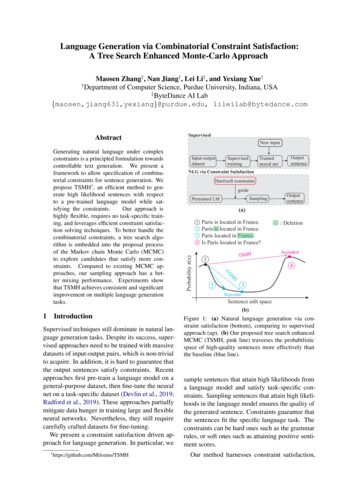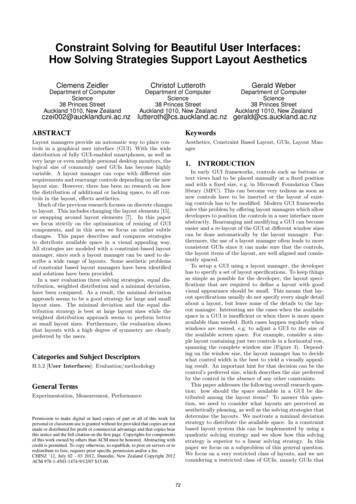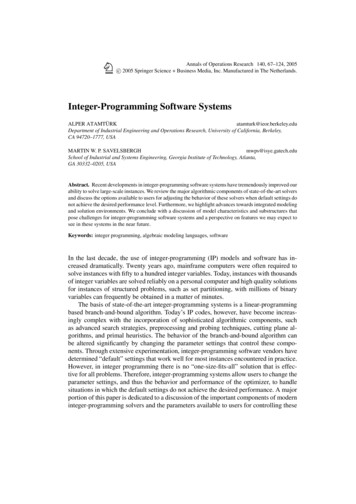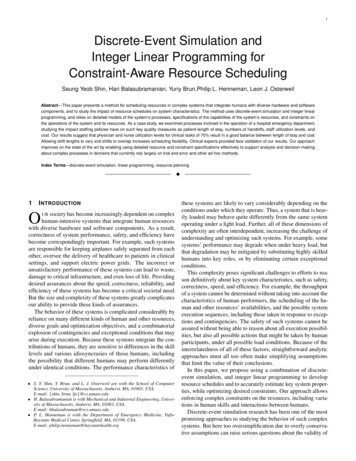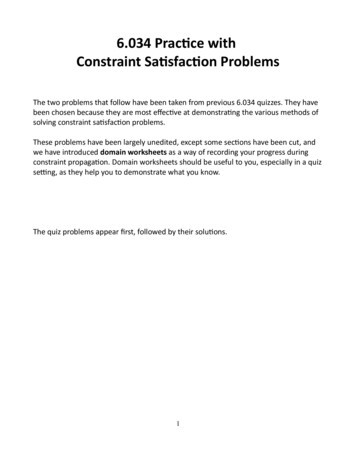
Transcription
6.034 Practice withConstraint Satisfaction Problems(Updated: 13/Oct/2014: The boar should have been propagated first, alphabetically.)The two problems that follow have been taken from previous 6.034 quizzes. They havebeen chosen because they are most effective at demonstrating the various methods ofsolving constraint satisfaction problems.These problems have been largely unedited, except some sections have been cut, andwe have introduced domain worksheets as a way of recording your progress duringconstraint propagation. Domain worksheets should be useful to you, especially in a quizsetting, as they help you to demonstrate what you know. Because these domainworksheets may appear on the second quiz or the final, we wanted to ensure that youwould be familiar with them in advance.The quiz problems appear first, followed by their solutions.1
Part I: Problems2
The Time Traveler's Convention (2009 Q2)The MIT Time Travel Society (MITTTS) has invited seven famous historical figures to each give alecture at the annual MITTTS convention, and you've been asked to create a schedule for them.Unfortunately, there are only four time slots available (1pm - 4pm), and you discover that there aresome restrictions on how you can schedule the lectures and keep all the convention attendees happy.For instance, physics students will be disappointed if you schedule Niels Bohr and Isaac Newton tospeak during the same time slot, because those students were hoping to attend both of thoselectures.After talking to some students who are planning to attend this year's convention, you determinethat they fall into certain groups, each of which wants to be able to see some subset of the timetraveling speakers. (Fortunately, each student identifies with at most one of the groups.) You writedown everything you know:The list of guest lecturers consists of Alan Turing, Ada Lovelace, Niels Bohr, Marie Curie,Socrates, Pythagoas, and Isaac Newton.1. Turing has to get home early to help win World War II, so he can only be assigned to the 1pmslot.2. The Course VIII students want to see the physicists: Bohr, Curie, and Newton.3. The Course XVIII students want to see the mathematicians: Lovelace, Pythagoras, and Newton.4. The members of the Ancient Greece Club wants to see the ancient Greeks: Socrates andPythagoras.5. The visiting Wellesley students want to see the female speakers: Lovelace and Curie.6. The CME students want to see the British speakers: Turing, Lovelace, and Newton.7. Finally, you decide that you will be happy if and only if you get to see both Curie andPythagoras. (Yes, even if you belong to one or more of thegroups above.)Part A:Diagram these constraints by drawing a line between the initials ofeach pair of guests who cannot share a time slot.Part BSearch for a solution using depth-first search only—without anyforward checking or propagation. The only check is to make sure thateach new assignment violates no constraint with any previousassignment. As a tiebreaker, assign a lecturer to the earliest availabletimeslot. Continue up to the first time you try and fail to assign anytime to Newton and must backtrack, at which point you give up andmove on to Part C to try a more sophisticated approach.Show your answers on the next two pages.3
Show your work by (1) filling out the domain worksheet on this page and (2) drawing the search tree on the next page.Constraint graph for this problemDomains for this problemT1L1 2 3 4B 1 2 3 4C1 2 3 4S1 2 3 4P1 2 3 4N 1 2 3 4Fill out this worksheet as you draw your search tree. There may be more rows than you need.1. Every time you assign a variable or remove a variable from the propagation queue, fill out a new rowin the table. (The same variable might appear in more than one row, especially if you have tobacktrack.)2. In that row, indicate which variable you assigned or de-queued; write its assigned value if it has one(e.g. X x), otherwise just write its name (X). In the second column, list the values that were justeliminated from neighboring variables as a result. If no values were just eliminated, write NONEinstead.3. If your search has to backtrack after assigning or de-queuing a variable: first, finish listing all valueseliminated from neighboring variables in the current row. Next, check the backtrack box in that row.Then, continue with the next assignment in the following row as usual.4. At some point, you might add several variables to your propagation queue at once. Break ties by addingvariables to your propagation queue in alphabeticalVar assignedor deList all values eliminated fromqueuedneighboring variablesexXY 3, 4Z 3Backtrack?order.Var assigned or List all values eliminated fromde-queuedneighboring variablesBacktrack? 10 1 11 2 12 3 13 4 14 5 15 6 16 7 17 8 18 9 19 (example)4
Draw your search tree for part B below.5
Part CYou're not fond of backtracking, so rather than wait and see how much backtracking you'll have to do,you decide to use depth first search with forward checking and propagation through singletons(propagation through domains reduced to size 1) to solve the problem. As before, show your work byfilling out the domain worksheet below and drawing the search tree on the following page.Constraint graph for this problemDomains for this problemT1L1 2 3 4B 1 2 3 4C1 2 3 4S1 2 3 4P1 2 3 4N 1 2 3 4Fill out this worksheet as you draw your search tree. There may be more rows than you need.5. Every time you assign a variable or remove a variable from the propagation queue, fill out a new rowin the table. (The same variable might appear in more than one row, especially if you have tobacktrack.)6. In that row, indicate which variable you assigned or de-queued; write its assigned value if it has one(e.g. X x), otherwise just write its name (X). In the second column, list the values that were justeliminated from neighboring variables as a result. If no values were just eliminated, write NONEinstead.7. If your search has to backtrack after assigning or de-queuing a variable: first, finish listing all valueseliminated from neighboring variables in the current row. Next, check the backtrack box in that row.Then, continue with the next assignment in the following row as usual.8. At some point, you might add several variables to your propagation queue at once. Break ties by addingvariables to your propagation queue in alphabeticalVar assignedor deList all values eliminated fromqueuedneighboring variablesY 3, 4Z 3Varassigned or List all values eliminated fromde-queued neighboring variablesBacktrack? 7 1 8 2 9 3 10 4 11 5 12 6 13 exX 3Backtrack?order.(example)6
Draw your search tree for Part C below.7
8
The Zoo in Killian Court (2011 Q2)In honor of MIT 150, MIT has decided to open a new zoo in Killian Court. They have obtained sevenanimals and built four enclosures. Because there are more animals than enclosures, some animalshave to be in the same enclosures as others. However, the animals are very picky about who they livewith. The MIT administration is having trouble assigning animals to enclosures, just as they often havetrouble assigning students to residences. As you have taken 6.034, they have asked you to plan whereeach animal goes.The animals chosen are a LION, ANTELOPE, HYENA, EVIL LION, HORNBILL, MEERKAT, and BOAR.They have given you the plans of the zoo layout.Each numbered area is a zoo enclosure. Multiple animals can go into the same enclosure, and not allenclosures have to be filled.Each animal has restrictions about where it can be placed.1. The LION and the EVIL LION hate each other, and do not want to be in the same enclosure.2. The MEERKAT and BOAR are best friends, and have to be in the same enclosure.3. The HYENA smells bad. Only the EVIL LION will share his enclosure.4. The EVIL LION wants to eat the MEERKAT, BOAR, and HORNBILL.5. The LION and the EVIL LION want to eat the ANTELOPE so badly that the ANTELOPE cannot bein either the same enclosure or in an enclosure adjacent to the LION or EVIL LION.6. The LION annoys the HORNBILL, so the HORNBILL doesn't want to be in the LION's enclosure.7. The LION is king, so he wants to be in enclosure 1.9
Using the reduced domains provided below, find one solution using depth first search with forwardchecking and propagation through domains reduced by any number of values (propagation throughreduced domains.) Show your work by filling out the domain worksheet on this page and drawing thesearch tree on the next page. Break ties in numerical order (1,2,3,4).Constraint graph for this problemLEL Mmust be equal B Hb Can'or at be ed ja q u acen lt Domains for this problemCan't be equalor adjacentL HA1Hb2 3 4A3 4EL2 3 4H2 3 4M1 2 3 4B1 2 3 4Reminder: At some point, you might add several variables to your propagation queue at once. Breakties by adding variables to your propagation queue in alphabetical order.Var assignedor deList all values eliminated fromqueuedneighboring variablesY 3, 4Z 3Var assigned or List all values eliminated fromde-queuedneighboring variablesBacktrack? 11 1 12 2 13 3 14 4 15 5 16 6 17 7 18 8 19 9 20 10 21 exXBacktrack?(example)10
11
Part II: Solutions12
SOLUTION: The Time Traveler's Convention (2009 Q2)The MIT Time Travel Society (MITTTS) has invited seven famous historical figures to each give alecture at the annual MITTTS convention, and you've been asked to create a schedule for them.Unfortunately, there are only four time slots available (1pm - 4pm), and you discover that there aresome restrictions on how you can schedule the lectures and keep all the convention attendees happy.For instance, physics students will be disappointed if you schedule Niels Bohr and Isaac Newton tospeak during the same time slot, because those students were hoping to attend both of thoselectures.After talking to some students who are planning to attend this year's convention, you determinethat they fall into certain groups, each of which wants to be able to see some subset of the timetraveling speakers. (Fortunately, each student identifies with at most one of the groups.) You writedown everything you know:The list of guest lecturers consists of Alan Turing, Ada Lovelace, Niels Bohr, Marie Curie,Socrates, Pythagoas, and Isaac Newton.1. Turing has to get home early to help win World War II, so he can only be assigned to the 1pmslot.2. The Course VIII students want to see the physicists: Bohr, Curie, and Newton.3. The Course XVIII students want to see the mathematicians: Lovelace, Pythagoras, and Newton.4. The members of the Ancient Greece Club wants to see the ancient Greeks: Socrates andPythagoras.5. The visiting Wellesley students want to see the female speakers: Lovelace and Curie.6. The CME students want to see the British speakers: Turing, Lovelace, and Newton.7. Finally, you decide that you will be happy if and only if you get to see both Curie andPythagoras. (Yes, even if you belong to one or more of the groups above.)Part A:Diagram these constraints by drawing a line between the initials of each pair of guests who cannotshare a time slot.Search for a solution using depth-first search only—without any forward checking or propagation. Theonly check is to make sure that each new assignment violates no constraint with any previousassignment. As a tiebreaker, assign a lecturer to the earliest available timeslot. Continue up to the firsttime you try and fail to assign any time to Newton and must backtrack, at which point you give upand move on to Part C to try a more sophisticated approach.Show your answers on the next two pages.13
Show your work by (1) filling out the domain worksheet on this page and (2) drawing the search tree on the next page.Constraint graph for this problemDomains for this problemT1L1 2 3 4B 1 2 3 4C1 2 3 4S1 2 3 4P1 2 3 4N 1 2 3 4Fill out this worksheet as you draw your search tree. There may be more rows than you need.1. Every time you assign a variable or remove a variable from the propagation queue, fill out a new rowin the table. (The same variable might appear in more than one row, especially if you have tobacktrack.)2. In that row, indicate which variable you assigned or de-queued; write its assigned value if it has one(e.g. X x), otherwise just write its name (X). In the second column, list the values that were justeliminated from neighboring variables as a result. If no values were just eliminated, write NONEinstead.3. If your search has to backtrack after assigning or de-queuing a variable: first, finish listing all valueseliminated from neighboring variables in the current row. Next, check the backtrack box in that row.Then, continue with the next assignment in the following row as usual.4. At some point, you might add several variables to your propagation queue at once. Break ties by addingvariables to your propagation queue in alphabeticalVar assignedor deList all values eliminated fromqueuedneighboring variablesexX1T 12Y 3, 4Z 3Backtrack?order.Var assigned or List all values eliminated fromde-queuedneighboring variablesBacktrack? 10P 2NONE NONE 11P 3NONE L 1NONE 12P 4NONE 3L 2NONE 13N 1NONE 4B 1NONE 14N 2NONE 5C 1NONE 15N 3NONE 6C 2NONE 16N 4NONE 7C 3NONE 17 8S 1NONE 18 9P 1NONE 19 (example)14
Draw your search tree for part B below.15
Part CYou're not fond of backtracking, so rather than wait and see how much backtracking you'll have to do,you decide to use depth first search with forward checking and propagation throughsingletons (propagation through domains reduced to size 1) to solve the problem. As before, showyour work by filling out the domain worksheet below and drawing the search tree on the followingpage.Constraint graph for this problemDomains for this problemT1L1 2 3 4B 1 2 3 4C1 2 3 4S1 2 3 4P1 2 3 4N 1 2 3 4Fill out this worksheet as you draw your search tree. There may be more rows than you need.1. Every time you assign a variable or remove a variable from the propagation queue, fill out a new rowin the table. (The same variable might appear in more than one row, especially if you have tobacktrack.)2. In that row, indicate which variable you assigned or de-queued; write its assigned value if it has one(e.g. X x), otherwise just write its name (X). In the second column, list the values that were justeliminated from neighboring variables as a result. If no values were just eliminated, write NONEinstead.3. If your search has to backtrack after assigning or de-queuing a variable: first, finish listing all valueseliminated from neighboring variables in the current row. Next, check the backtrack box in that row.Then, continue with the next assignment in the following row as usual.4. At some point, you might add several variables to your propagation queue at once. Break ties by addingvariables to your propagation queue in alphabeticalVar assignedor deList all values eliminated fromqueuedneighboring variablesexX1T 1L 1N 12L 2P 2N 23B 1C 14C 3N 35NP6PSY 3, 4Var assigned or List all values eliminated fromde-queuedneighboring variablesBacktrack? 7S 2 8P 1 9N 4 10 11 4 12 1 13 PZ 3Backtrack?order. 3C 2(example)16NONE NONE NONE
Draw your search tree for Part C below.17
18
SOLUTION: The Zoo in Killian Court (2011 Q2)In honor of MIT 150, MIT has decided to open a new zoo in Killian Court. They have obtained sevenanimals and built four enclosures. Because there are more animals than enclosures, some animalshave to be in the same enclosures as others. However, the animals are very picky about who they livewith. The MIT administration is having trouble assigning animals to enclosures, just as they often havetrouble assigning students to residences. As you have taken 6.034, they have asked you to plan whereeach animal goes.The animals chosen are a LION, ANTELOPE, HYENA, EVIL LION, HORNBILL, MEERKAT, and BOAR.They have given you the plans of the zoo layout.Each numbered area is a zoo enclosure. Multiple animals can go into the same enclosure, and not allenclosures have to be filled.Each animal has restrictions about where it can be placed.1. The LION and the EVIL LION hate each other, and do not want to be in the same enclosure.2. The MEERKAT and BOAR are best friends, and have to be in the same enclosure.3. The HYENA smells bad. Only the EVIL LION will share his enclosure.4. The EVIL LION wants to eat the MEERKAT, BOAR, and HORNBILL.5. The LION and the EVIL LION want to eat the ANTELOPE so badly that the ANTELOPE cannot bein either the same enclosure or in an enclosure adjacent to the LION or EVIL LION.6. The LION annoys the HORNBILL, so the HORNBILL doesn't want to be in the LION's enclosure.7. The LION is king, so he wants to be in enclosure 1.19
Using the reduced domains provided below, find one solution using depth first search with forwardchecking and propagation through domains reduced by any number of values (propagation throughreduced domains.) Show your work by filling out the domain worksheet on this page and drawing thesearch tree on the next page. Break ties in numerical order (1,2,3,4).Constraint graph for this problemLEL M must be equalB Hb Can'or at be ed ja q u acen lt Domains for this problemCan't be equalor adjacentL A H1Hb2 3 4A3 4EL2 3 4H2 3 4M1 2 3 4B1 2 3 4Reminder: At some point, you might add several variables to your propagation queue at once. Breakties by adding variables to your propagation queue in alphabetical order.Var assignedor deList all values eliminated fromqueuedneighboring variablesexX1L 12Hb 2EL 23ELA 3, 44Hb 3EL 35EL6Y 3, 4Z 3Backtrack?Var assigned or List all values eliminated fromde-queuedneighboring variablesBacktrack? 11MNONE 12A 4NONE 13EL 2NONE 14H 2NONE 15M 1A 3 16BNONE HNONE 17B 1NONE 7AEL 4H 4 18 8ELM 2B 2 19 9HNONE 20 10BNONE 21 NONEH 2H 3(example)20B 3,4
21
6.034 Practice with Constraint Satisfaction Problems (Updated: 13/Oct/2014: The boar should have been propagated first, alphabetically.) The two problems that follow have been taken from previous 6.034 quizzes. They have been chosen because they are most effective at demonstrating the various methods of solving constraint satisfaction problems.
